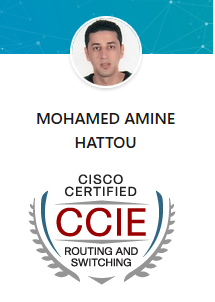





Cette formation vous donne les connaissances pour maitriser l’implémentation et le diagnostic des technologies avancé de routage et switching , les services d’infrastructures ,la sécurité ainsi que l’automatisation des infrastructure elle vous permet de passer l’examen ENCOR 300 410 qui sera disponible à partir de février 2020 afin d’avoir la certification « Cisco Certified Specialist - Enterprise Advanced Infrastructure Implementation » ou la certif CCNP Entreprise si vous avez déjà passé l’examen ENCOR 300 401
Cette formation vous familiarise avec la mise en œuvre et le dépannage de technologies et de services de routage avancés, notamment:
CCNA ou équivalent

Amine is a Networking expert he has more then 10 years experiance in ISP Core Network ; he hold serveral Certfications from different Network equipement vendor ; the valuable one is CCIE "Cisco Certified Internetwork Expert".
other cisco certificates :
CCNP RS ; CCNP SP ; CCNA RS/SEC/SP
Cisco certified academy instructor CCAI
Cisco instructor trainer (ITQ)
Juniper certificates:
JNCIA ; JNCIS-ENT, JNCIP-ENT, JNCIS-SP; JNCIP-SP
1.0 Layer 3 Technologies |
||
|
1.1 Troubleshoot administrative distance (all routing protocols) 1.2 Troubleshoot route map for any routing protocol (attributes, tagging, filtering) 1.3 Troubleshoot loop prevention mechanisms (filtering, tagging, split horizon, route poisoning) 1.4 Troubleshoot redistribution between any routing protocols or routing sources 1.5 Troubleshoot manual and auto-summarization with any routing protocol 1.6 Configure and verify policy-based routing 1.7 Configure and verify VRF-Lite 1.8 Describe Bidirectional Forwarding Detection 1.9 Troubleshoot EIGRP (classic and named mode) · 1.9.a Address families (IPv4, IPv6) · 1.9.b Neighbor relationship and authentication · 1.9.c Loop-free path selections (RD, FD, FC, successor, feasible successor, stuck in active) · 1.9.d Stubs · 1.9.e Load balancing (equal and unequal cost) · 1.9.f Metrics 1.10 Troubleshoot OSPF (v2/v3) · 1.10.a Address families (IPv4, IPv6) · 1.10.b Neighbor relationship and authentication · 1.10.c Network types, area types, and router types o 1.10.c Point-to-point, multipoint, broadcast, nonbroadcast o 1.10.c (ii) Area type: backbone, normal, transit, stub, NSSA, totally stub o 1.10.c (iii) Internal router, backbone router, ABR, ASBR o 1.10.c (iv) Virtual link · 1.10.d Path preference 1.11 Troubleshoot BGP (Internal and External) · 1.11.a Address families (IPv4, IPv6) · 1.11.b Neighbor relationship and authentication (next-hop, mulithop, 4-byte AS, private AS, route refresh, synchronization, operation, peer group, states and timers) · 1.11.c Path preference (attributes and best-path) · 1.11.d Route reflector (excluding multiple route reflectors, confederations, dynamic peer) · 1.11.e Policies (inbound/outbound filtering, path manipulation) |
||
2.0 VPN Technologies |
||
|
2.1 Describe MPLS operations (LSR, LDP, label switching, LSP) 2.2 Describe MPLS Layer 3 VPN 2.3 Configure and verify DMVPN (single hub) · 2.3.a GRE/mGRE · 2.3.b NHRP · 2.3.c IPsec · 2.3.d Dynamic neighbor · 2.3.e Spoke-to-spoke |
||
3.0 Infrastructure Security |
||
|
3.1 Troubleshoot device security using IOS AAA (TACACS+, RADIUS, local database) 3.2 Troubleshoot router security features · 3.2.a IPv4 access control lists (standard, extended, time-based) · 3.2.b IPv6 traffic filter · 3.2.c Unicast reverse path forwarding (uRPF) 3.3 Troubleshoot control plane policing (CoPP) (Telnet, SSH, HTTP(S), SNMP, EIGRP, OSPF, BGP) 3.4 Describe IPv6 First Hop security features (RA guard, DHCP guard, binding table, ND inspection/snooping, source guard) |
||
4.0 Infrastructure Services |
||
|
4.1 Troubleshoot device management · 4.1.a Console and VTY · 4.1.b Telnet, HTTP, HTTPS, SSH, SCP · 4.1.c (T)FTP 4.2 Troubleshoot SNMP (v2c, v3) 4.3 Troubleshoot network problems using logging (local, syslog, debugs, conditional debugs, timestamps) 4.4 Troubleshoot IPv4 and IPv6 DHCP (DHCP client, IOS DHCP server, DHCP relay, DHCP options) 4.5 Troubleshoot network performance issues using IP SLA (jitter, tracking objects, delay, connectivity) 4.6 Troubleshoot NetFlow (v5, v9, flexible NetFlow) 4.7 Troubleshoot network problems using Cisco DNA Center assurance (connectivity, monitoring, device health, network health) |
||